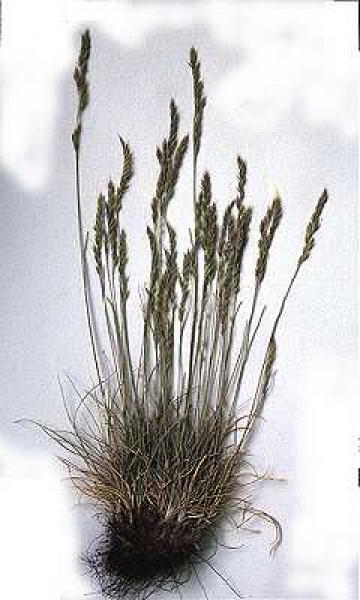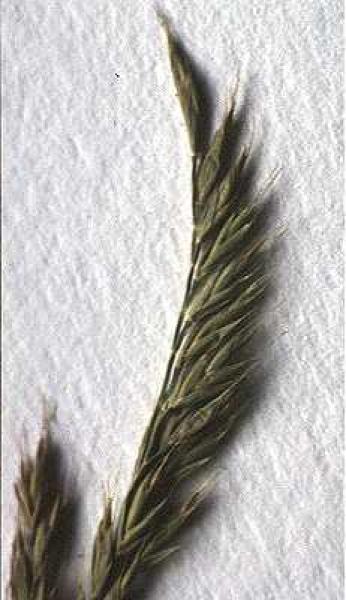Mountain Fescue
Festuca saximontana var. saximontana None
- Class
- Monocotyledoneae (Monocots)
- Family
- Poaceae (Grass Family)
- State Protection
- Endangered
Listed as Endangered by New York State: in imminent danger of extirpation in New York. For animals, taking, importation, transportation, or possession is prohibited, except under license or permit. For plants, removal or damage without the consent of the landowner is prohibited.
- Federal Protection
- Not Listed
- State Conservation Status Rank
- S1
Critically Imperiled in New York - Especially vulnerable to disappearing from New York due to extreme rarity or other factors; typically 5 or fewer populations or locations in New York, very few individuals, very restricted range, very few remaining acres (or miles of stream), and/or very steep declines.
- Global Conservation Status Rank
- G5T5
Secure globally - Both the species as a whole and the subspecies/variety are common in the world; widespread and abundant (but may be rare in some parts of its range).
Summary
Did you know?
Sheep Fescue is also sometimes known as "Rocky Mountain Fescue"; "saximontana" is a combination of the Latin for rock (saxi) and mountain (montana) (Fernald 1950). Although rare in New York, this species is an important forage species for animals of mountain habitats in the western U.S. and Canada.
State Ranking Justification
There is currently only 1 existing occurrence and 1 or 2 historical records in New York.
Short-term Trends
Additional inventory and monitoring is needed to determine current population trends in the state.
Long-term Trends
This species has always been rare in New York. The single existing population has persisted at the site since at least 1910 when it was first discovered.
Conservation and Management
Threats
The existing population may be subject to natural threats such as rockslides. As a boreal species, sheep fescue may also be negatively affected by climate changes.
Conservation Strategies and Management Practices
Rock climbers occasional use the cliffs which are the one known site for this species in New York. Management and education should focus on protecting this and the other rare species at the site from any associated human disturbance.
Research Needs
Additional searching of appropriate habitat and monitoring of the known population is needed.
Habitat
Habitat
The only known New York population occurs on a dry anorthosite cliff with in the High Peaks of the Adirondacks.
Associated Ecological Communities
- Cliff community
(guide)
A community that occurs on vertical exposures of resistant, non-calcareous bedrock (such as quartzite, sandstone, or schist) or consolidated material; these cliffs often include ledges and small areas of talus.
Associated Species
- Deschampsia flexuosa
- Diervilla lonicera (bush-honeysuckle)
- Luzula spicata
- Sibbaldiopsis tridentata
- Trisetum spicatum (narrow oat grass)
- Woodsia ilvensis (rusty woodsia, rusty cliff fern)
Range
New York State Distribution
This species is now known in New York only from a single location in the High Peaks of the Adirondacks, though there are historical records from scattered other locations in eastern New York.
Global Distribution
Festuca saximontana var. saximontana grows in open habitats in Canada, Alaska, and Greenland, and perhaps in the Russian Far East. Its range in the U.S. includes most of the west, but east of the Mississippi River it is only known from Wisconsin, Michigan, New York, and Vermont.
Identification Comments
General Description
This perennial grass is 25 to 50 (60) cm tall, and grows in dense tufts. The basal leaves are hairless, involute (curled upon themselves), and less than 3 mm wide, with the leaf sheaths open for about half of their length. The stems are usually 3 to 5 times as tall as the leaves of the vegetative shoots, and topped by a narrow, erect infloresence (spreading slightly during flowering) 1 to 10 cm long. The spikelets are 4.5 to 8.8 mm long, with 3 to 5 florets each. The anthers are short, up to 1.7 (-2) mm long (FNA 2007).
Best Life Stage for Proper Identification
This grass species is best identified when in flower, though identification from fruiting material is also possible.
Similar Species
Festuca ovina and Festuca trachyphylla have longer anthers (2-3 mm), and are introduced, weedy, and not restricted to alpine habitats. Variety saximontana is the only variety of Festuca saximontana native to New York, and tends to have taller (3 to 5 times as tall as the vegetative leaves) culms than the other varieties.
Best Time to See
Sheep fescue flowers mainly during June, and the fruits mature in June and July.
- Flowering
- Fruiting
The time of year you would expect to find Mountain Fescue flowering and fruiting in New York.
Mountain Fescue Images
Taxonomy
Mountain Fescue
Festuca saximontana var. saximontana None
- Kingdom Plantae
- Phylum Anthophyta
- Class Monocotyledoneae
(Monocots)
- Order Cyperales
- Family Poaceae (Grass Family)
- Order Cyperales
- Class Monocotyledoneae
(Monocots)
- Phylum Anthophyta
Additional Common Names
- Sheep Fescue
Synonyms
- Festuca ovina var. saximontana (Rydb.) Gleason
Additional Resources
References
Edinger, Gregory J., D.J. Evans, Shane Gebauer, Timothy G. Howard, David M. Hunt, and Adele M. Olivero (editors). 2002. Ecological Communities of New York State. Second Edition. A revised and expanded edition of Carol Reschke's Ecological Communities of New York State. (Draft for review). New York Natural Heritage Program, New York State Department of Environmental Conservation. Albany, NY. 136 pp.
Fernald, M.L. 1950. Gray's manual of botany. 8th edition. D. Van Nostrand, New York. 1632 pp.
Flora of North America Editorial Committee. 2007a. Flora of North America North of Mexico. Vol. 24. Magnoliophyta: Commelinidae (in part): Poaceae, part 1. Oxford Univ. Press, New York. xxviii + 911 pp.
Gleason, Henry A. and A. Cronquist. 1991. Manual of Vascular Plants of Northeastern United States and Adjacent Canada. The New York Botanical Garden, Bronx, New York. 910 pp.
Holmgren, Noel. 1998. The Illustrated Companion to Gleason and Cronquist's Manual. Illustrations of the Vascular Plants of Northeastern United States and Adjacent Canada. The New York Botanical Garden, Bronx, New York.
Mitchell, Richard S. and Gordon C. Tucker. 1997. Revised Checklist of New York State Plants. Contributions to a Flora of New York State. Checklist IV. Bulletin No. 490. New York State Museum. Albany, NY. 400 pp.
New York Natural Heritage Program. 2024. New York Natural Heritage Program Databases. Albany, NY.
Voss, E.G. 1972. Michigan flora: A guide to the identification and occurrence of the native and naturalized seed-plants of the state. Part I. Gymnosperms and monocots. Cranbrook Institute of Science and Univ. Michigan Herbarium. Ann Arbor. 488 pp.
Weldy, T. and D. Werier. 2010. New York flora atlas. [S.M. Landry, K.N. Campbell, and L.D. Mabe (original application development), Florida Center for Community Design and Research http://www.fccdr.usf.edu/. University of South Florida http://www.usf.edu/]. New York Flora Association http://newyork.plantatlas.usf.edu/, Albany, New York
Weldy, Troy W. and David Werier. 2005. New York Flora Atlas. [S.M. Landry, K.N. Campbell, and L.D. Mabe (original application development), Florida Center for Community Design and Research. University of South Florida]. New York Flora Association, Albany, NY. Available on the web at (http://newyork.plantatlas.usf.edu/).
Links
About This Guide
Information for this guide was last updated on: May 22, 2008
Please cite this page as:
New York Natural Heritage Program. 2024.
Online Conservation Guide for
Festuca saximontana var. saximontana.
Available from: https://guides.nynhp.org/sheep-fescue/.
Accessed July 26, 2024.

